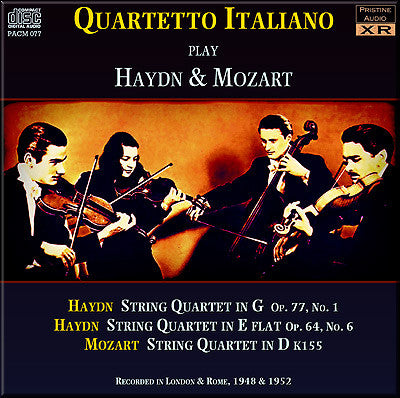
This album is included in the following sets:
This set contains the following albums:
- Producer's Note
- Full Track Listing
- Cover Art
Excellent Mozart and Haydn from one of the great quartets
Quartetto Italiano's sound superbly enhanced in these new 32-bit XR transfers
The earlier recording, 1948's Haydn E flat Quartet, most certainly was issued on 78s (AK2159-60) and must have been among Decca's last recordings made direct to disc - this was clearly apparent when restoring the recording from their own LP transfer, in this case a mint ten-inch 33rpm German pressing, where remnants of surface noise and swish clearly indicated original 78rpm rotation.
Also appreciable is the decrease in general surface noise with the advent of tape, coupled with increased general recording fidelity between 1948 and 1952. That said, each of these recordings has benefited greatly from 32-bit XR remastering, in which I've been able to bring out a great deal of clarity and fine detail, whilst retaining an open, organic sound.
I was also able to enhance the originally rather dry sound of the Santa Cecilia recordings, using precisely mapped acoustic models of the hall in which the recordings were made, to "place the listener" in the centre of the seventh row of the auditorium - thus allowing the sound of the hall itself to round out the tone of the quartet in a pleasing and entirely authentic manner.
Andrew Rose
-
HADYN String Quartet in G major, Op. 77, No. 1, Hob III:81
-
MOZART String Quartet No. 2 in D major, K155 (K134a)
Recording producers: Victor Olof & John Culshaw
Recording Engineer: Gil Went
Recorded 1-10 July, 1952
Santa Cecilia, Rome -
HADYN String Quartet in E flat major, Op. 64, No. 6, Hob III:64
Recorded 11 & 20 November, 1948
West Hampstead Studios, London
Transfers from Decca LXT2811 & LW50170
XR remastering by Andrew Rose at Pristine Audio, April 2011
Cover artwork based on a photograph of Quartetto Italiano
Total duration: 50:55
Quartetto Italiano:
Paolo Borciani, violin
Elisa Pegreffi, violin
Piero Farulli, viola
Franco Rossi, cello
Gramophone Historic Review
Haydn Quartet Op 64 No 4
There is just one phrase which I think over-steps the bounds of ciassical style—if you have a score you can find it in the slow movement, just before the minor section and again just before the end. (Bars with a sf.) But this is nothing to set against such excellent interpretation.
As to balance and recording, also good, though I do not find the cello line entirely satisfactory. I am not sure if the player has perhaps a rather tubby tone or whether the recorders might have given us a little more of him—possibly both. At any rate, in the middle, minor, section of the slow movement I needed my score to know that there is a bass line of B flats for the first few bars: and elsewhere I found his line not consistently telling.
Yet this is a very good set of records and another work which you should at least hear and judge for yourself."
T. H., The Gramophone, December 1949

